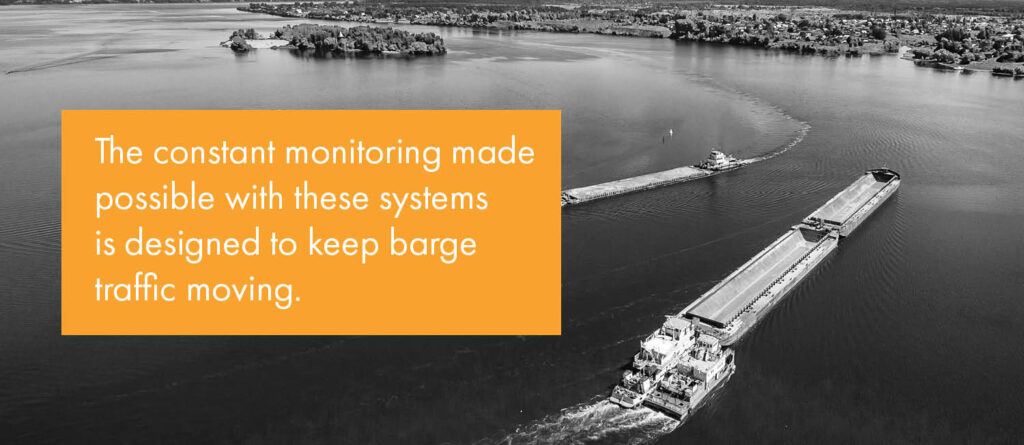The barge transportation industry plays a vital role in the US economy, facilitating the movement of vast quantities of commodities and raw materials along the nation’s inland waterways. However, managing vessel traffic on these complex waterway networks presents unique challenges. From detecting potential collisions and navigational hazards to optimizing logistics and fleet deployment, there is a pressing need for more intelligent and automated monitoring solutions.
With recent advancements in automation technologies, there is significant potential to overhaul traffic monitoring practices in the barge industry—enhancing safety, efficiency, and overall operational excellence. New technology is uncovering opportunities for improving processes for everything from traffic and fleet management to preventing catastrophic collisions and environmental disasters.
And as with most emerging tech…despite its potential, actual implementation can be complicated and expensive.
To address these challenges, researchers and innovators focusing on the shipping and transportation industries are exploring opportunities to utilize existing hardware and traffic monitoring systems, augmenting them with additional sensors and data from drones and satellites to apply new functionality made possible by AI and machine learning. This helps to address cost issues and to prevent interruption of shipping that would be required to install completely new monitoring systems.
Intelligent Vessel Tracking and Collision Avoidance
One of the most promising applications of AI and machine learning in the barge industry is intelligent vessel tracking and collision avoidance. These advanced systems can continuously monitor and analyze real-time data from multiple inputs, including the radar, GPS, and automatic identification systems (AIS) that are already nearly ubiquitous on boats today. Through automation, this data can be analyzed to detect potential vessel conflicts or near-miss situations. By leveraging machine learning algorithms, these systems can learn from historical traffic patterns, vessel behavior, and environmental conditions to make accurate predictions and issue timely warnings to barge operators.
Furthermore, researchers are testing traffic management systems that use new and existing sensors for automated navigation systems that suggest course adjustments or even autonomous maneuvering to avoid collisions. Some researchers have proposed AI-powered systems that integrate satellite data with other sources like AIS to enable automated traffic monitoring and management. This not only enhances safety but also optimizes boat routing to reduce travel times and fuel consumption.

Intelligent Vessel Tracking and Hazard Detection
The vast network of inland waterways presents various potential hazards, including submerged obstacles, shifting channel conditions, and adverse weather events. Traditionally, monitoring these hazards has relied heavily on manual inspections and reports from barge crews, which can be time-consuming, subjective, and prone to human error. Current radar and AIS technologies have limitations in providing a comprehensive view of waterway traffic, especially in areas with limited visibility or sensor coverage.
AI-powered monitoring systems have the potential to revolutionize this process by continuously analyzing data from various sources, including satellite imagery, drone footage, and sensor networks deployed along the waterways. These systems can detect and identify potential hazards with increased accuracy, so that crews can mitigate risks and ensure safe passage for their boats. Machine learning algorithms can be trained to recognize patterns and anomalies in satellite imagery to detect submerged objects, changing water levels, or the formation of sandbars. Sensor networks equipped with advanced analytics can monitor weather conditions, water currents, and other environmental factors, providing real-time updates and alerts to operators and waterway authorities.
Optimized Fleet Management and Logistics
The inland barge industry requires intricate logistics operations to manage the coordinated movement of vessels, scheduling of crews, and management of cargo loads. AI and automation technologies offer significant opportunities to optimize these processes to increase efficiency and reduce costs.
Machine learning algorithms analyze current and historical traffic patterns, cargo demand, and environmental conditions to generate optimized vessel routing and scheduling options. These algorithms can consider various factors, such as vessel capabilities, cargo types, weather conditions, and waterway restrictions to develop efficient and cost-effective transportation plans.
New sensors and AI-powered systems can be integrated with cargo tracking and inventory management systems for real-time monitoring of shipments. Up-to-the-minute data can in turn inform decision-making in response to delays or disruptions . This level of visibility and coordination can significantly improve barge traffic monitoring and management.
Improved Barge Traffic Management
Geographic information system (GIS) technology is becoming increasingly important for managing inland waterway traffic. GIS platforms can integrate various data sources like vessel tracking, weather, and waterway conditions onto interactive maps. The resulting intelligence can be used to visualize traffic patterns, identify bottlenecks, and optimize vessel routing, especially when integrated with sensor data from existing AIS systems. AI and machine learning can analyze this data to predict traffic flows and provide decision support for fleets and waterway authorities.
The constant monitoring made possible with these systems is designed to keep barge traffic moving .
Researchers have also proposed using computer vision and deep learning techniques on image data from drones and satellites to automatically detect and track vessels on inland waterways . Their model can identify different vessel types and sizes, monitor their trajectories, and potentially predict traffic conflicts or navigation hazards. This automated vessel monitoring could enhance barge traffic monitoring with an eye toward efficiency and safety.
How to Integrate Improved Automation Today
Although the technological advancements—and their potential benefits—described above are largely still in the research and testing phases, there are numerous ways to integrate existing automation tech to enhance barge traffic management today.
By automating business processes—things like boat-to-shore communication, documentation, billing, data analysis, and so on—in an incremental fashion, barge operators can realize efficiencies while freeing crew members to focus on critical tasks related to efficient navigation and safety.
BargeOps technology is leading the way in the barging industry with fleet, towing, and barge management software that drives process automation via an easy-to-use platform. BargeOps Onboard provides automated exchange of data about barge movements between shore-based dispatch and boats, making streamlined barge traffic monitoring a reality now. By implementing the automation tools available today, barge companies can increase efficiency while positioning themselves to navigate the rising tides of emerging tech.


